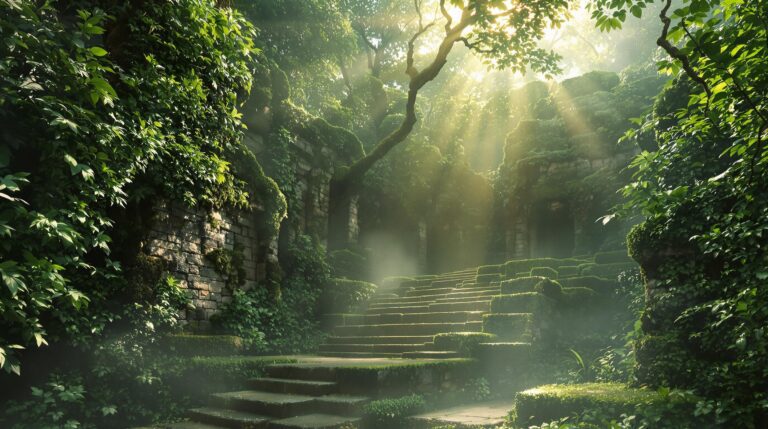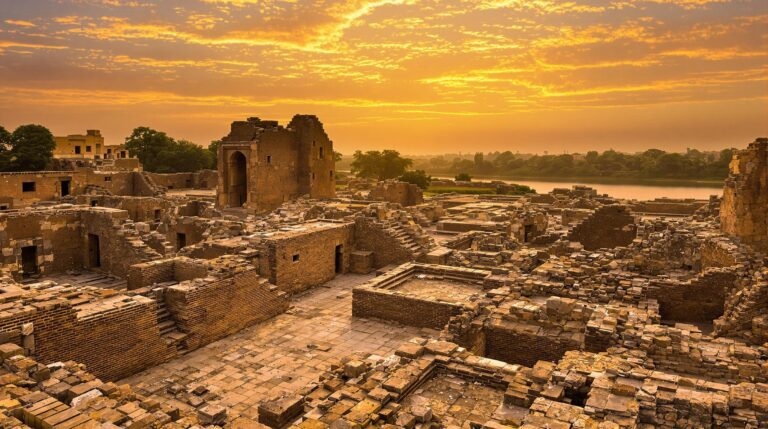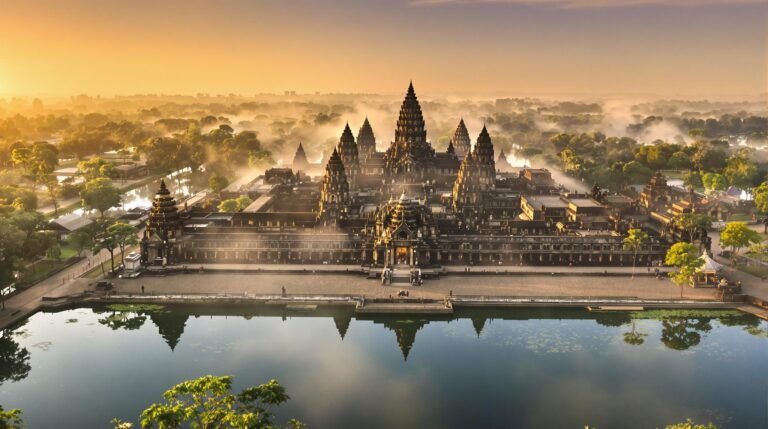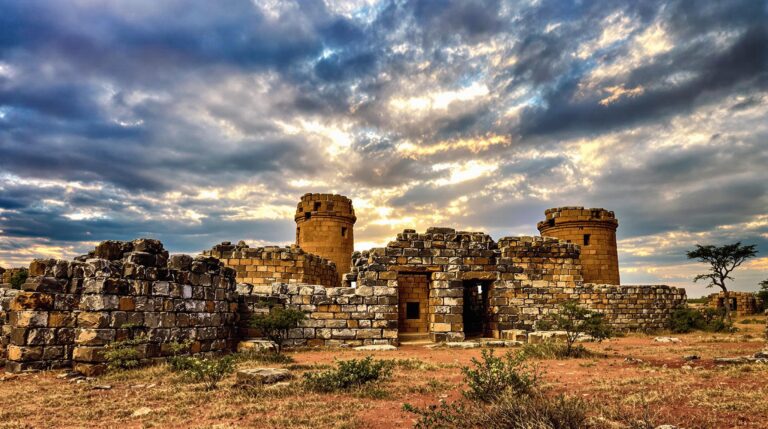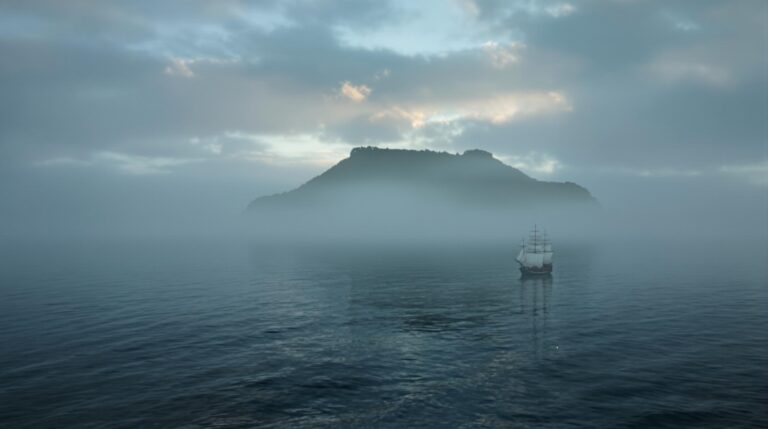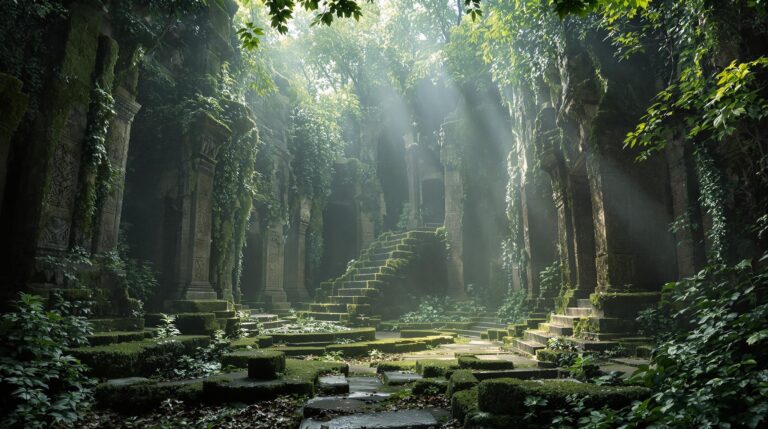Dwarka: Krishna’s Legendary Sunken City
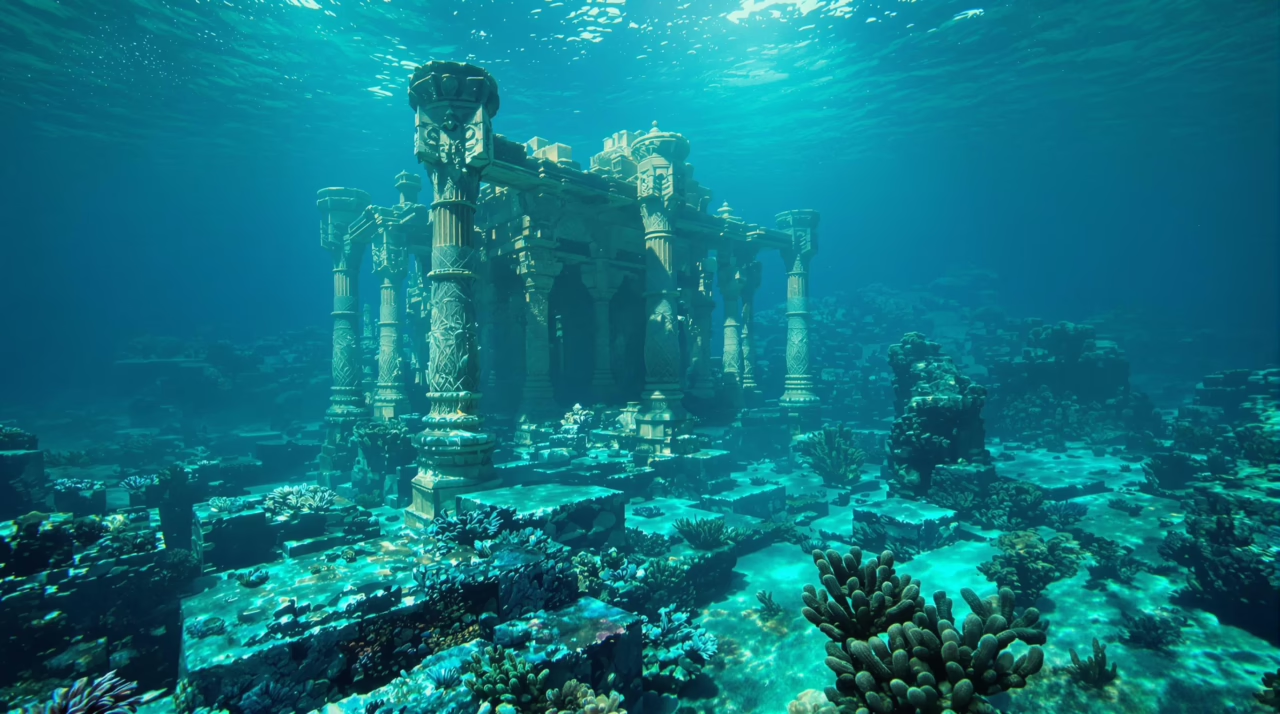
Dwarka, often shrouded in myth, poses intriguing questions about its existence and fate.
Historical texts like the Mahabharata paint a vivid picture of its grandeur and significance.
Yet, the enigma of its submergence remains. What geological events or cultural narratives contributed to this legend?
As modern explorations uncover remnants of this ancient city, the intersection of archaeology and mythology invites further examination. What truths lie beneath the waves, waiting to be revealed?
TL;DR
Hide- Dwarka is a legendary city mentioned in the Mahabharata, known for its grandeur and spiritual significance as the kingdom of Lord Krishna.
- The city's submergence is linked to geological events, with myths suggesting catastrophic floods or tsunamis contributing to its disappearance.
- Archaeological findings reveal advanced engineering and vibrant trade patterns, challenging traditional narratives about Dwarka's historical importance.
- Dwarka attracts pilgrims and tourists, highlighting the need for balanced conservation efforts to protect its fragile archaeological sites.
- Modern research combines marine archaeology and technology to uncover submerged remnants, shedding light on Dwarka's rich cultural heritage.
The Ancient Origins in Sacred Texts, References to Dwarka
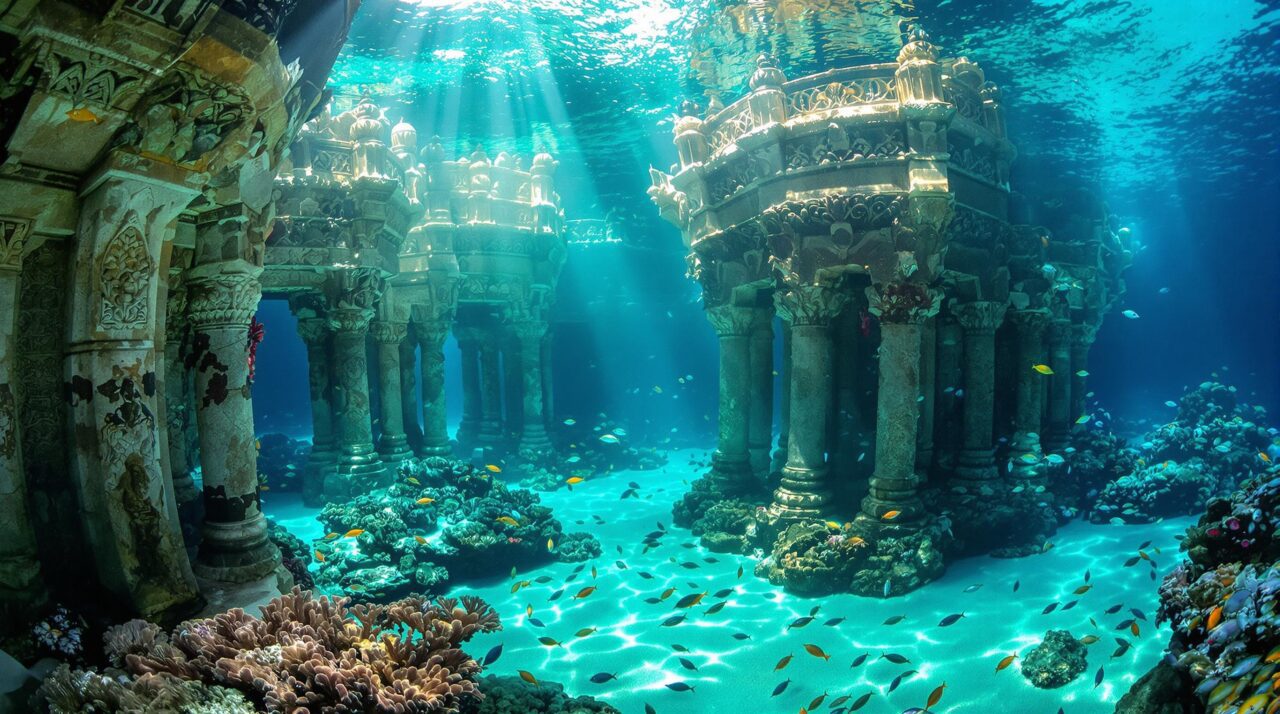
The ancient texts of the Mahabharata and Puranas present intriguing references to Dwarka, painting a vivid picture of its grandeur and eventual submergence.
How do these sacred narratives shape our understanding of this legendary city and its significance in the cultural memory of India?
Exploring these sources offers a pathway to decipher the intertwining of mythology and history surrounding Krishna’s fabled domain.
References in Mahabharata and Puranas
The references to Dwarka in the Mahabharata and various Puranas suggest a kingdom steeped in unparalleled prosperity and divine significance.
What layers of meaning can be uncovered about Krishna’s role as a leader and the spiritual aura attributed to his domain?
These ancient texts invite contemplation on the interplay between myth and reality, challenging perceptions of this legendary city.
Significance of Krishna’s Kingdom
Krishna’s kingdom, often depicted as a thriving center of culture and spirituality, holds profound significance in ancient Indian texts.
Its importance can be explored through:
- Cultural Renaissance: A hub for art, music, and dance.
- Spiritual Legacy: An embodiment of dharma and righteousness.
- Political Unity: A model of governance and diplomacy.
- Mythical Geography: A symbol of divine intervention in human affairs.
Mythical Prosperity and Spiritual Aura
Often regarded as a beacon of wealth and spirituality, the legendary city of Dwarka emerges vividly in ancient texts such as the Mahabharata and various Puranas.
These scriptures depict a domain overflowing with opulence, divine connections, and a harmonious existence.
The intertwining of material prosperity and spiritual depth invites contemplation on how myth shapes cultural identity and influences contemporary understanding of sacred spaces.
Growth and Splendor of Dwarka
The evolution of Dwarka stands as a demonstration to its architectural marvels and sophisticated city layout, inviting exploration of its design and infrastructure.
How did such innovations contribute to the city’s cultural and economic prominence in its time?
This inquiry opens a window into the grandeur that defined Dwarka, reflecting its historical significance and enduring legacy.
Architectural Marvels and City Layout
The architectural grandeur of Dwarka invites scrutiny, particularly in its fortified walls and meticulously planned gateways that hint at a strategic foresight.
Amidst this robust defense, the palaces and temples emerge as symbols of spiritual and royal opulence, reflecting the city’s cultural richness.
How did these elements intertwine to create a harmonious coastal charm that not only captivated its inhabitants but also echoed the legends of Krishna?
Fortified Walls and Planned Gateways
While exploring the architectural marvels of Dwarka, one cannot help but be drawn to the imposing fortified walls and meticulously planned gateways that encapsulate this legendary city.
These structures reveal insights into its strategic brilliance and cultural significance:
- Defensive architecture against invasions
- Symbolic entrances reflecting prosperity
- Complex layout promoting safety and movement
- Integration with natural landscapes
Such elements evoke intrigue and admiration.
Palaces, Temples, and Coastal Charm
Numerous palaces and temples dot the landscape of Dwarka, each embodying the city’s rich history and architectural ingenuity.
These structures reflect a harmonious blend of intricate designs and coastal charm, inviting contemplation of their purpose and significance.
How did such craftsmanship arise in this ancient city?
Each edifice stands as a tribute to the spiritual and cultural aspirations of its time, echoing tales of divine legends.
Cultural and Economic Influence
The cultural and economic influence of Dwarka invites examination of its strategic trade routes that connected land and sea, fostering an environment ripe for commerce.
This lively exchange not only enriched the local economy but also nurtured a flourishing scene of arts and crafts, reflecting the city’s prosperity.
How did these elements intertwine to shape Dwarka’s identity as a hub of growth and splendor in ancient times?
Trade Routes Across Land and Sea
As trade routes flourished across both land and sea, Dwarka emerged as a pivotal hub of commerce and cultural exchange, enchanting merchants and travelers alike.
This lively center of activity was characterized by:
- Diverse goods flowing from distant lands
- Cultural interactions enriching local traditions
- Strategic maritime connections enhancing trade efficiency
- Economic prosperity fostering innovation and growth
Dwarka’s influence was undeniably profound.
Flourishing Arts and Crafts
Amidst the lively exchanges of trade and culture, the arts and crafts of Dwarka flourished, reflecting both the city’s prosperity and its rich heritage.
Intricate textiles, vivid pottery, and exquisite jewelry emerged, each telling a story of creativity and tradition.
What techniques fueled this artistic explosion? How did these creations influence neighboring cultures?
Such questions evoke the enduring spirit of Dwarka’s artistic legacy.
The Great Submergence Theories
Theories surrounding the great submergence of Dwarka evoke a tapestry of geological factors and ancient narratives.
Scholars ponder how tectonic shifts may have conspired with cataclysmic events to reshape the landscape, leading to the city’s legendary disappearance.
Such inquiries not only illuminate the potential realities of Dwarka’s fate but also challenge the boundaries between myth and history.
Geological Factors and Tectonic Shifts
The geological history of the region surrounding Dwarka raises intriguing questions about the factors that may have contributed to its submergence.
Evidence of coastal erosion and the relentless rise in sea levels suggest a dynamic interplay of natural forces that could have gradually overwhelmed this ancient city.
How these elements coalesced to create the legendary tale of Dwarka’s disappearance remains a fascinating mystery waiting to be unraveled.
Evidence of Coastal Erosion Over Time
Coastal erosion has long been a silent architect of landscapes, shaping coastlines and altering the very fabric of civilizations.
The evidence of this phenomenon can be distilled into key observations:
- Persistent wave action against shorelines.
- Sediment displacement over millennia.
- Historical accounts of land loss.
- Geological studies revealing shifting tectonic plates.
Such factors beckon inquiry into the fate of ancient cities like Dwarka.
Impact of Rising Sea Levels
Rising sea levels present a formidable challenge to understanding the fate of submerged cities like Dwarka, prompting questions about the interplay between geological factors and tectonic shifts.
Theories suggest that tectonic movements may have contributed to the city’s submergence, intertwining natural forces with human history.
This inquiry into Dwarka’s demise raises profound reflections on civilization’s vulnerabilities to nature’s relentless power and change.
Accounts of Ancient Disasters
The sudden disappearance of Dwarka has been shrouded in myths that echo through time, suggesting catastrophic events that could explain its submergence.
Scholars ponder whether a colossal tsunami or a series of devastating floods might have contributed to the city’s fate, intertwining natural disaster with legend.
Such accounts invite further exploration into the delicate balance between historical truth and the narratives that shape cultural memory.
Myths on the City’s Sudden Disappearance
Numerous myths surrounding the sudden disappearance of Dwarka spark intrigue and speculation about its fate.
Scholars and enthusiasts have proposed various theories, including:
- Divine wrath for moral decay.
- Cataclysmic natural events like earthquakes.
- A mystical curse placed by rivals.
- The city vanishing through a portal into another dimension.
These narratives, steeped in cultural significance, invite deeper exploration of human belief and the mysteries of history.
Possible Tsunami or Flooding Events
While ancient texts and archaeological findings often hint at catastrophic events, the possibility of a tsunami or massive flooding as the cause of Dwarka’s submergence warrants careful consideration.
Experts speculate that geological shifts or climatic changes could have triggered such disasters, leading to the city’s swift disappearance.
This theory invites a deeper exploration into the relationship between nature’s fury and human civilization’s fragility.
Modern Underwater Findings
Recent marine archaeology efforts have shed light on the submerged remnants surrounding Dwarka, raising questions about the historical accuracy of local legends.
Ongoing research initiatives continue to unearth artifacts and structures that challenge traditional narratives, suggesting a complex civilization beneath the waves.
As findings accumulate, the potential for new insights into this legendary city becomes increasingly tantalizing.
Marine Archaeology Efforts
Recent marine archaeology efforts around Dwarka have revealed intriguing findings through advanced sonar scans and meticulous diving expeditions.
These modern techniques have uncovered artifacts that suggest the presence of submerged structures, prompting questions about the city’s historical significance.
As researchers examine these discoveries, the allure of understanding Krishna’s legendary city continues to captivate both scholars and enthusiasts alike.
Advanced Sonar Scans and Diving Expeditions
As underwater explorers investigate the depths off the coast of Dwarka, the application of advanced sonar scanning technology reveals tantalizing glimpses of a once-thriving civilization.
Key findings include:
- Complex underwater structures
- Potential roadways leading to ancient harbors
- Dispersed artifacts hinting at daily life
- Anomalies suggesting significant human activity
These discoveries ignite curiosity about the enigmatic past and the stories hidden beneath the waves.
Artifacts Hinting at Submerged Structures
What stories do the artifacts recovered from Dwarka’s depths tell about a civilization long submerged?
These remnants—ceramics, tools, and structures—whisper of advanced engineering and lively trade.
Marine archaeology reveals patterns of life, hinting at a society intertwined with the sea.
Each find invites speculation about cultural practices, technological prowess, and the enigmatic disappearance of this legendary city, igniting the imagination of those who seek freedom in understanding history.
Ongoing Research Initiatives
Recent initiatives surrounding the sunken city of Dwarka reveal a burgeoning collaboration among experts from diverse fields, merging archaeology with marine science and technology.
This interdisciplinary approach aims to enhance the mapping and preservation of underwater sites, shedding light on the intricacies of ancient urban life.
As researchers continue to uncover new findings, questions arise about the implications of these discoveries for our understanding of history and cultural heritage.
Collaboration with Experts in Various Fields
While the search for Dwarka’s sunken ruins continues to captivate scholars and enthusiasts alike, the collaboration with experts from diverse fields has proven essential in revealing the mysteries of this legendary city.
Key contributions include:
- Archaeological excavations
- Geophysical surveys
- Historical linguistics
- Marine biology
These interdisciplinary efforts illuminate Dwarka’s past, urging the quest for understanding to explore deeper into its enigmatic legacy.
Mapping and Preservation of Underwater Sites
Advancements in technology have propelled the mapping and preservation of underwater sites, particularly in the search for Dwarka’s submerged remnants. Researchers employ sonar imaging and submersible vehicles to uncover hidden structures and artifacts.
These modern initiatives not only aim to document historical significance but also to protect fragile ecosystems, raising questions about humanity’s responsibility to safeguard both heritage and the natural world.
Dwarka’s Lasting Significance
The significance of Dwarka extends far beyond its submerged ruins, serving as a pivotal pilgrimage site that draws devotees seeking spiritual connection to Lord Krishna.
This ancient city not only enriches the religious landscape of India but also embodies a cultural heritage that has the potential to inspire future generations.
How might the stories and traditions stemming from Dwarka continue to shape collective identity and values in an ever-evolving world?
Pilgrimage and Religious Value
Dwarka’s allure as a pilgrimage site is underscored by the numerous temples dedicated to Lord Krishna, which attract devotees from across the globe.
Each ceremony held within these sacred spaces serves to honor the city’s storied past, inviting reflections on the intersection of faith and history.
How do these rituals shape the collective memory of a city that once thrived, and what does this legacy mean for contemporary spirituality?
Krishna Temples Drawing Devotees
A remarkable tapestry of faith and devotion unfolds in the temples dedicated to Lord Krishna, drawing countless devotees to the ancient city of Dwarka.
These sacred spaces evoke profound emotions and foster spiritual exploration, enchanting visitors with:
- Architectural grandeur
- Mystical rituals
- Sacred narratives
- Community gatherings
Each element invites reflection, prompting seekers to connect with their inner selves and the divine legacy of Krishna.
Ceremonies Honoring the City’s Legendary Past
While exploring the intricate fabric of Dwarka’s history, one cannot overlook the ceremonies that pay homage to its legendary past, reflecting the city’s enduring significance as a pilgrimage destination.
These rituals, steeped in devotion and tradition, invite contemplation on the intersection of myth and reality. They evoke a sense of belonging among participants, reaffirming their connection to the divine legacy of Krishna’s sunken city.
Cultural Heritage for Future Generations
As Dwarka’s archaeological treasures continue to surface, how can educational programs be structured to guarantee that new generations grasp their significance?
The challenge lies in balancing the influx of tourism with effective conservation efforts, a task that necessitates innovative strategies.
What frameworks can be developed to protect this ancient city while fostering appreciation for its rich cultural heritage?
Educational Programs Highlighting Archaeological Discoveries
How can the lively mosaic of Dwarka’s archaeological discoveries be effectively shared with future generations?
Educational programs play an essential role in this endeavor.
- Interactive workshops on excavation techniques
- Virtual reality experiences of ancient Dwarka
- Community-led storytelling sessions
- Collaborations with local schools for heritage education
Such initiatives ignite curiosity and foster a deeper appreciation for the city’s enduring cultural significance.
Balancing Tourism with Conservation
Although the allure of Dwarka’s sunken city draws countless visitors, the challenge lies in balancing the influx of tourism with the imperative of conservation.
How can one preserve the fragile remnants of history while embracing the lively energy of tourism?
This delicate equilibrium is essential for sustaining Dwarka’s cultural heritage, ensuring that future generations may also connect with the stories embedded in its depths.
Wrapping Up
Dwarka, with its mystical allure and profound historical roots, continues to captivate scholars and tourists alike.
Intriguingly, recent underwater explorations have identified structures dating back over 5,000 years, suggesting that its majestic past may be even older than previously believed.
This raises questions about the interplay between myth and history, inviting further investigation into how such an ancient civilization thrived and ultimately vanished.
As marine archaeology progresses, Dwarka’s secrets may yet illuminate the depths of human civilization.
